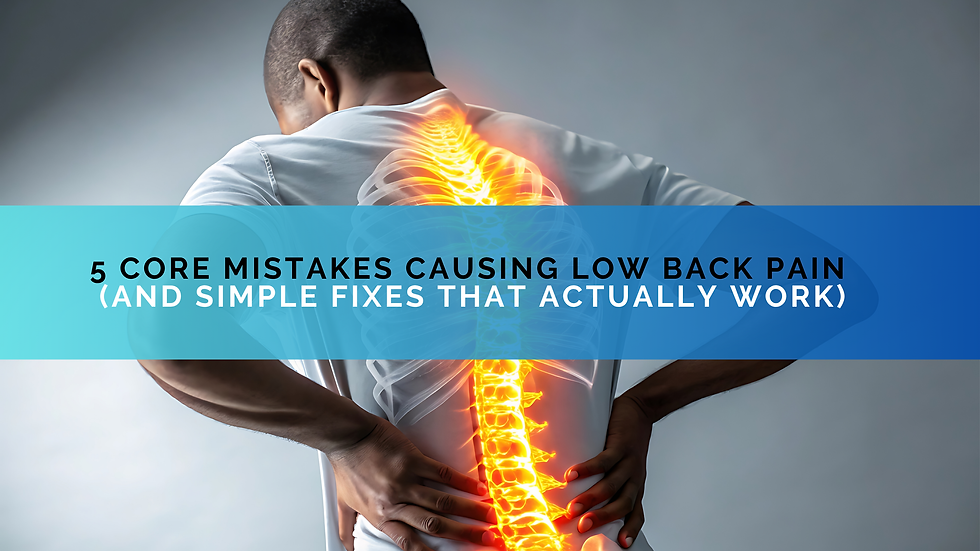Fitness Myths: Debunking Common Misconceptions
- Jennifer Walker CPT-SNS-LBS-CHC

- Apr 29, 2024
- 3 min read
In the vast landscape of fitness advice, myths often abound, leading to confusion and misinformation. Let's shed light on some of the most prevalent fitness myths and uncover the truth behind them.

Spot Reduction Spot reduction, the idea that targeted exercises like crunches can burn fat in specific areas, is a persistent myth. Fat loss occurs uniformly throughout the body, not just in targeted regions. While exercises may strengthen muscles, they won't necessarily reduce fat in those areas alone. Therefore, a comprehensive approach that includes cardiovascular exercise, strength training, and a balanced diet is essential for overall fat loss and body composition improvement.
Cardio Is King Cardiovascular exercise is undoubtedly beneficial for heart health and calorie burning, but it's not the sole path to fitness. Strength training plays an equally crucial role in building muscle, increasing metabolism, and improving overall body composition. Incorporating both cardio and strength training into your routine yields optimal results, promoting balanced fitness and overall well-being.
No Pain, No Gain The popular mantra "no pain, no gain" suggests that discomfort is necessary for progress in fitness. However, pushing through pain can lead to injury and setbacks rather than progress. It's essential to distinguish between discomfort, which is a natural part of exercise, and actual pain, which may indicate an injury that requires rest and recovery. Listening to your body and practicing moderation is key to sustainable progress in fitness.
More Is Better The belief that longer workouts equate to better results is a common misconception. While consistency and dedication are essential for progress in fitness, quality trumps quantity. Overtraining can lead to burnout, fatigue, and increased risk of injury. Rest and recovery are equally important components of any fitness regimen, allowing the body to adapt and grow stronger over time.
You Can't Build Muscle After 40 Age is often cited as a barrier to building muscle, but it's merely a number when it comes to fitness. While muscle mass may decline with age, strength training and proper nutrition can help maintain and even build muscle well into later years. Consistency, proper form, and progressive overload are key factors in building muscle regardless of age.
You Need Supplements to Get Fit While supplements can complement a healthy diet and fitness regimen, they're not essential for success. Whole foods provide essential nutrients and should form the foundation of any nutrition plan. While supplements may be beneficial for specific goals or deficiencies, they're not a substitute for a balanced diet rich in fruits, vegetables, lean proteins, and whole grains.
Women Will Bulk Up from Lifting Weights The fear of becoming overly muscular from strength training is a common misconception, particularly among women. In reality, most women lack the testosterone levels necessary for significant muscle hypertrophy. Strength training promotes a lean, toned physique and offers numerous health benefits without causing excessive muscle growth. Incorporating strength training into your routine can enhance overall fitness and improve body composition.
Crunches Are the Key to Six-Pack Abs While core exercises like crunches can strengthen abdominal muscles, they alone won't reveal six-pack abs. Visible abs require a combination of factors, including proper nutrition, overall fat loss, and full-body strength training. Compound exercises that engage multiple muscle groups, such as squats and deadlifts, are more effective for burning calories and building muscle, including the core muscles necessary for a defined midsection.
10,000 Steps Myth The notion that 10,000 steps per day is necessary for health is a common misconception. While walking is beneficial for cardiovascular health and overall well-being, there's no magic number of steps that guarantees optimal fitness. The key is to stay active throughout the day, whether through walking, exercise, or other activities, and to find a movement routine that works for you. Focusing on overall physical activity and maintaining a balanced diet is more important than reaching a specific step count.
Rest Days are Optional While rest is crucial for recovery, it doesn't mean you have to be inactive. Active recovery, such as gentle yoga, walking, or swimming, can promote healing while keeping you moving. Listen to your body and find the balance that works for you.
By debunking these common fitness myths, we can pave the way for a more informed and effective approach to achieving our health and fitness goals. Remember, knowledge is power on the journey to a fitter, healthier you!





Comments